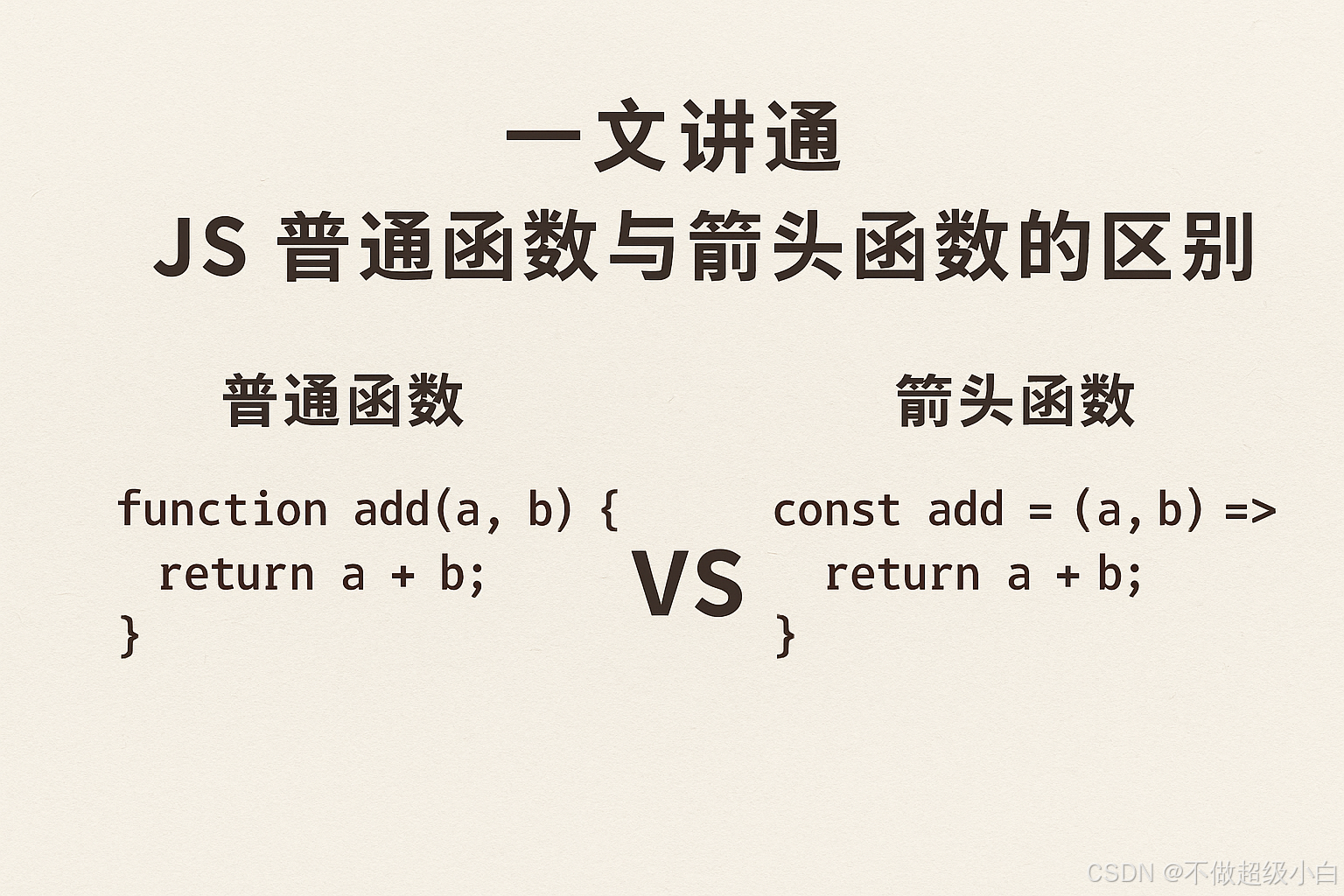一文讲通JS普通函数与箭头函数的区别
文章目录
- JS中普通函数和箭头函数的区别
- 1. 语法差异
- 2. `this` 指向
- 普通函数的 `this`
- 箭头函数的 `this`
- 3. `arguments` 对象
- 4. 可作为构造函数
- 5. `prototype` 属性
- 6. 什么时候用箭头函数
- 7. 总结对比表
- 8. 思考题

JS中普通函数和箭头函数的区别
在现代JavaScript开发中,函数是最基础也是最重要的构造。随着ES6的普及,箭头函数(Arrow Function)被广泛使用,但普通函数(Function Declaration / Function Expression)仍然不可或缺。本文将通过对比示例,全面解析两者的区别,并帮你理解在不同场景下如何选择使用。
1. 语法差异
普通函数的声明方式有两种:
// 函数声明
function add(a, b) {return a + b;
}// 函数表达式
const multiply = function(a, b) {return a * b;
};
箭头函数的写法更加简洁:
const add = (a, b) => a + b;
const multiply = (a, b) => {return a * b;
};
总结:
- 箭头函数可以省略
function关键字。 - 单行表达式可以省略大括号和
return。 - 参数只有一个时可以省略括号,如:
x => x * 2。
2. this 指向
这是普通函数与箭头函数最本质的区别。
普通函数的 this
普通函数的 this 指向调用它的对象,调用方式不同,this 也不同:
const obj = {name: "Alice",greet: function() {console.log(this.name);}
};obj.greet(); // Aliceconst greetFunc = obj.greet;
greetFunc(); // undefined 或 window / globalThis
箭头函数的 this
箭头函数没有自己的 this,它会捕获定义时的外层 this:
const obj = {name: "Alice",greet: () => {console.log(this.name);}
};obj.greet(); // undefined
注意:箭头函数通常不适合作为对象方法,因为它的
this并不指向对象本身。
3. arguments 对象
普通函数可以访问内置的 arguments 对象:
function sum() {let total = 0;for (let i = 0; i < arguments.length; i++) {total += arguments[i];}return total;
}sum(1, 2, 3); // 6
箭头函数没有自己的 arguments,需要使用 剩余参数:
const sum = (...args) => args.reduce((a, b) => a + b, 0);
sum(1, 2, 3); // 6
4. 可作为构造函数
普通函数可以用 new 创建实例:
function Person(name) {this.name = name;
}
const p = new Person("Alice");
console.log(p.name); // Alice
箭头函数不能作为构造函数:
const Person = (name) => { this.name = name; };
new Person("Alice"); // TypeError: Person is not a constructor
5. prototype 属性
普通函数有 prototype,箭头函数没有:
function Foo() {}
console.log(Foo.prototype); // Foo {}const Bar = () => {};
console.log(Bar.prototype); // undefined
这意味着箭头函数不能用来定义类或传统的原型方法。
6. 什么时候用箭头函数
- 回调函数:如
map、filter、forEach等 - 不需要
this或arguments的函数 - 保持函数体简洁,减少冗余
示例:
const nums = [1, 2, 3];
const squares = nums.map(n => n * n);
console.log(squares); // [1, 4, 9]
7. 总结对比表
| 特性 | 普通函数 | 箭头函数 |
|---|---|---|
| 语法 | function 声明或表达式 | 简洁 ()=>{} |
this | 调用时决定 | 继承外层 this |
arguments | 有 | 无,需要 ...args |
| 构造函数 | 可使用 new | 不可使用 new |
prototype | 有 | 无 |
| 适用场景 | 对象方法、构造函数、需要 arguments | 简短回调函数,保持 this 绑定 |
8. 思考题
-
为什么在事件监听中,箭头函数可以避免
this指向window?答:普通函数是动态绑定,使用的是动态this;箭头函数是词法绑定,使用的是词法this,继承定义时外层作用域的this,可以达到保持上下文的效果。
-
如何在箭头函数中访问外层函数的
arguments?答:构造闭包使用外层的
arguments或使用剩余参数...args。 -
什么时候仍然必须使用普通函数而不能用箭头函数?
答:需要使用构造函数、动态this以及arguments参数等情况下。
